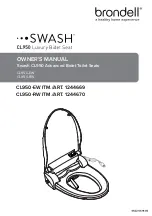
Solid waste
With normal use, a family of four produces around 7 litres
of solid waste per week. To create compost that is nice
and loose, add a few litres of Special Humus once a week.
You need to base the emptying frequency on how
often the toilet is used and by how many people. For
example, after 4-6 weeks’ use by 4 people it will be
time to switch composting chambers. Lift out the inner
container and carry it out, add a little ordinary topsoil
and put the lid on. Place the container in a shady place in
the garden for post-composting. It takes 6 to 9 months
of post-composting as a rule before the contents can be
used as a fertiliser.
Put a latrine bag in the other inner container and fit
this in place beneath the toilet.
General advice
Wash the urine bowl with water now and again to prevent
salt deposits.
If insects get into the toilet, you can sprinkle BioLet
Insektsstopp on the compost.
If you do experience a bad smell in the room, check
the pipe connections are properly sealed and that there
is an adequate air supply.
To clean the toilet, use only mild detergent. Never
use abrasive cleaning agents.
If you leave the house for more than 2 days, switch off
the fan and put the lid down.
3
How the Separera 30 NE works
This urine separating toilet is constructed from eco-friendly material and is designed to cope with high demand
over many years.What does separating waste mean? Well, the toilet is designed so that on any toilet visit, solid
waste is separated from the liquid (urine).This means that Separera has two chambers, one for urine, and another
for solid waste. Both must be dealt with in accordance with local regulations.
Contacting Environmental Health
Contact Environmental Health office regarding local health regulations. This always applies when installing any
type of toilet.
The Separera box contains
Toilet • Lid • Urine hose (1.5 m) • Special Humus • Insect netting • 2 Composting Chambers (40 litres) • Latrine
Bags (10)
The installation kit (accessories)
The installation kit contains; ventilation pipes (4x1.1 m ventilation pipe with 55 mm outer diameter), exterior
pipe (1 x 1.1m with 110 mm outer diameter), insulation (2 x 1 m), reducing coupling, roof flashing and insect
netting.
Further accessories
Pipe Bends 30° and 45°, Insulation, Ventilation Pipe, Special Humus, Ejector Tank, Latrine Bags.
Separera in cross section
1. Upper section
2. Toilet seat
3. Air intake
4. Compost cover
5. Compost chamber
6. Inside container with a plastic bag
7. Lower section
8. Removeable lid
9. Cover
2
4
3
2
1
7
6
5
8
9
Urine drainage
Urine can be drained away in a number of different
ways. Check what is required by your local authority;
there are variations depending on ground conditions
and the water table. You should never just deal with it as
you see fit, as this could have a harmful effect. A house-
hold of 4 people will produce around 35 litres of urine
per week; this is equivalent to about 3 kg of artificial fer-
tiliser, which is a considerable amount.
There must be a drop in the hose coming out and away
from the toilet to avoid salt deposits; for longer hoses, it
may be helpful to connect it to a 32 mm PVC pipe.
GREY WATER:
Connect the hose to an existing drainage system such
as a percolation basin or similar. It is important that
pipes have enough of a drop for urine not to remain
standing in the hose. If necessary, the hose may be ang-
led to create a water trap. In this case it is important to
pour through a litre of hot water now and again to pre-
vent the build-up of salt deposits in the hose.
INFILTRATION:
May consist of a pit or a ditch outside the house. Put
large stones/macadam around the hose mouth and then
fill with sand.
EJEKTORTANK:
If you want to use the urine as liquid fertiliser, there is a
special tank available as an accessory; it can be ordered
from your dealer or from us. Urine contains large quan-
tities of nutrient salts, making it a useful fertiliser for
lawns. With the ejector tank you get the correct dilution
for watering; connection to 1/2” garden hose.
MAINTENANCE






















